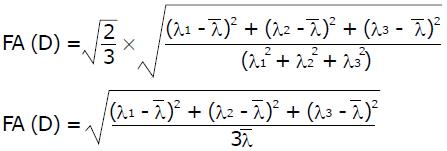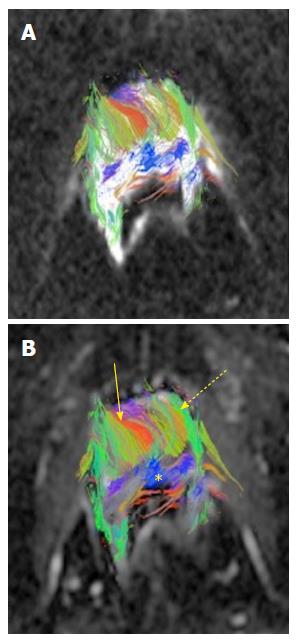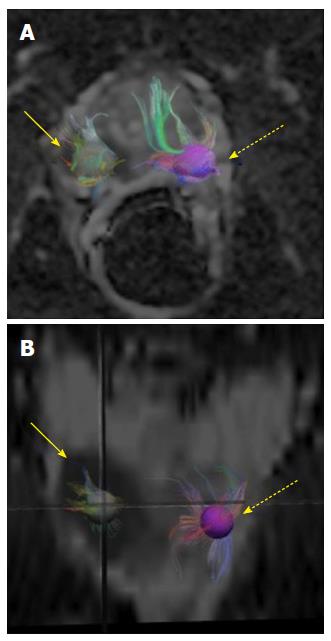Copyright
©The Author(s) 2016.
World J Radiol. Apr 28, 2016; 8(4): 397-402
Published online Apr 28, 2016. doi: 10.4329/wjr.v8.i4.397
Published online Apr 28, 2016. doi: 10.4329/wjr.v8.i4.397
Math 1 Math(A1).
Math 2 Math(A1).
Figure 1 Three dimensional fiber tracts superimposed on axial diffusion weighted images (A) and apparent diffusion coefficient (B) image revealing rich fiber tract anatomy and complex architecture of the prostate gland with tract heterogeneity.
The visualization software allows color-coding of the tracts wherein the tractographic fiber display shows right/left (red - straight arrow), anterior/posterior (green - dotted arrow), superior/inferior (blue) tracts based on the eigenvector orientations.
Figure 2 Axial (A) and coronal apparent diffusion coefficient (B) images with superimposed three dimensional fiber tracts in the two three dimensional-regions of interests.
The tumor (arrows in A, B) in the right mid peripheral zone is well demarcated in this 59-year-old man with a Gleason’s score of 8. Decreased number of fibers passing through the tumor region regions of interest in comparison with the normal region (dotted arrows in A, B) is subjectively apparent. The quantitative tract densities were 1.48 in the tumor region and 2.09 in the normal region.
Figure 3 Bar graph comparing the tract densities, apparent diffusion coefficient and fractional anisotropy values for tumor and normal parenchyma.
aStatistically significant P value; whiskers represent std. error of mean; all ADC values in mm2/s. ADC: Apparent diffusion coefficient; FA: Fractional anisotropy.
- Citation: Hedgire S, Tonyushkin A, Kilcoyne A, Efstathiou JA, Hahn PF, Harisinghani M. Quantitative study of prostate cancer using three dimensional fiber tractography. World J Radiol 2016; 8(4): 397-402
- URL: https://www.wjgnet.com/1949-8470/full/v8/i4/397.htm
- DOI: https://dx.doi.org/10.4329/wjr.v8.i4.397













